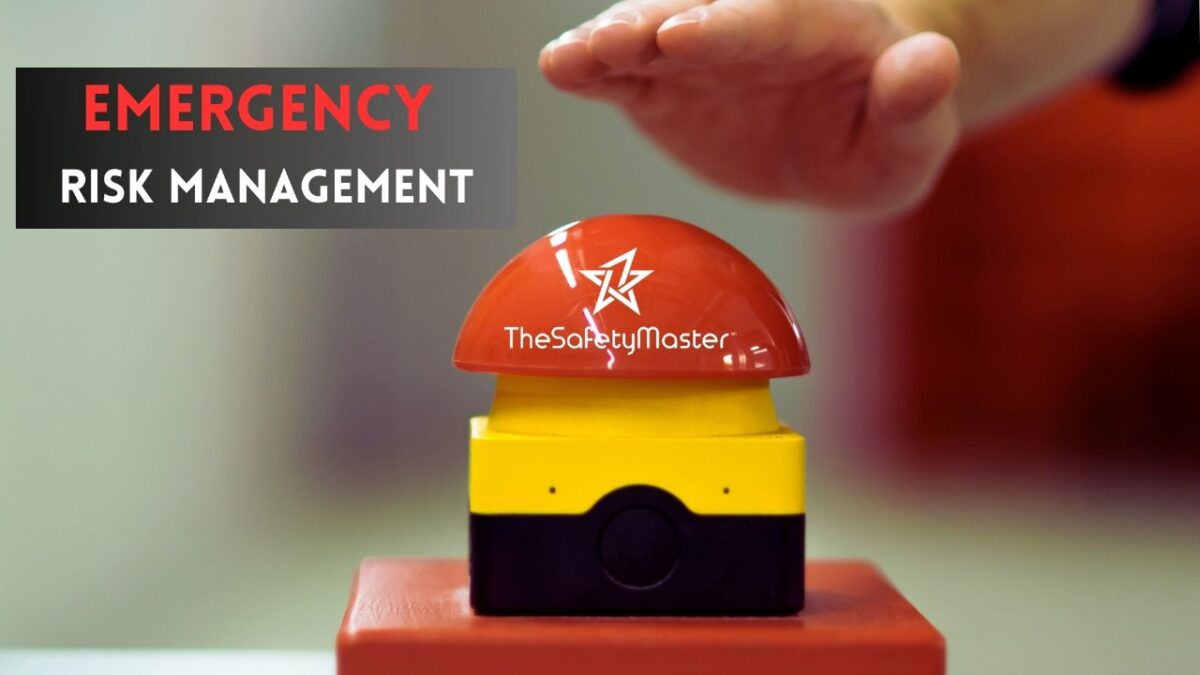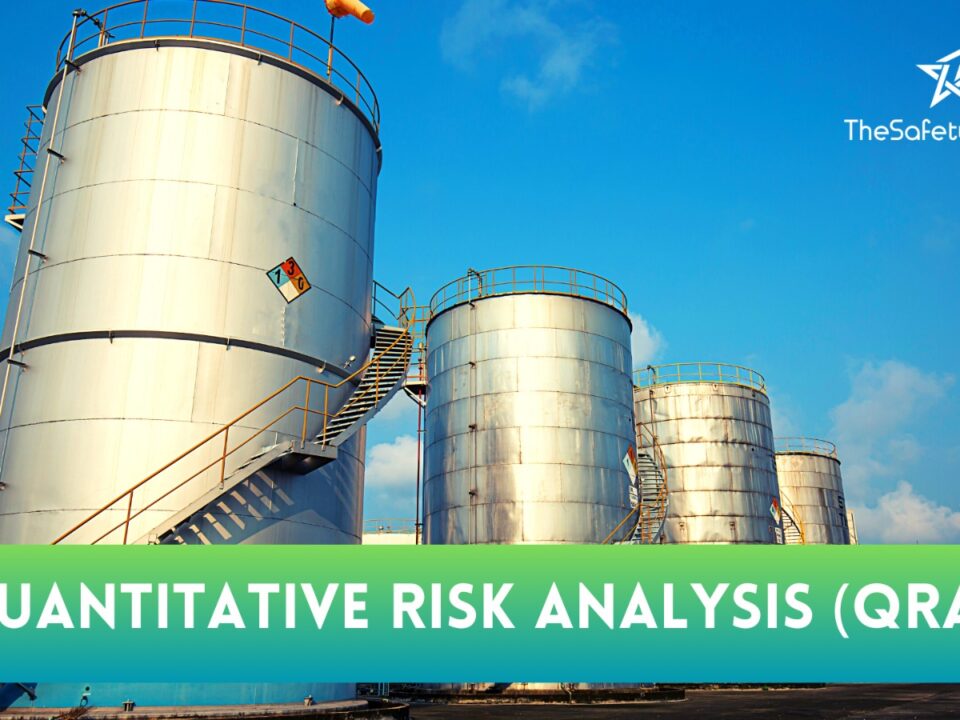Strategic Emergency Planning: The Crucial Connection Between Risk Assessment and Hazard Identification

Streamlining Safety Protocols: How Safety Software Is Revolutionizing Indian Industrial Practices
October 27, 2023
The Importance of HAZOP Study in Preventing Accidents and Promoting Safe Operations in Indian Chemical Plants
October 30, 2023In this article, we delve into the often overlooked but vitally important connection between risk assessment and hazard identification in the realm of strategic emergency planning. By carefully analysing potential risks and identifying hazards, organizations can effectively prepare for and mitigate potential disasters. Join us as we unravel the complex web of interconnectedness between these crucial elements. Brace yourself for an enlightening exploration that promises to provide you with valuable insights, practical tips, and a deeper understanding of the pivotal role risk assessment and hazard identification play in safeguarding lives and protecting our communities. Get ready to elevate your emergency planning to new heights. Let’s get started.
Introduction
Emergencies and disasters can strike unexpectedly, wreaking havoc on communities and organizations. In the face of such calamities, having a well-thought-out strategic emergency plan becomes paramount. However, ensuring the effectiveness of these plans requires a deep understanding of two crucial elements: risk assessment and hazard identification. In this comprehensive article, we will delve into the intricate connection between risk assessment and hazard identification in the realm of strategic emergency planning. We will explore the importance of these processes, their key components, and how they work in tandem to mitigate potential risks and prepare for unforeseen events. By examining real-life case studies and discussing best practices, we aim to provide valuable insights that can enhance emergency preparedness for both individuals and organizations
Understanding Strategic Emergency Planning
In comprehending the intricacies of Strategic Emergency Planning, it is crucial to delve into its profound essence. At its core, this discipline represents a meticulous and proactive approach to mitigating the adverse effects of unforeseen events. It encompasses a broad spectrum of preparedness measures aimed at safeguarding lives, infrastructure, and societal well-being. By fostering a culture of resilience and adaptability, strategic emergency planning empowers communities to effectively respond to and recover from potential hazards. Within the realm of Strategic Emergency Planning, every facet is meticulously crafted with precision. It entails thorough risk assessments that involve identifying potential vulnerabilities and evaluating their likelihood and potential impact on critical assets. From natural disasters to technological failures or even human-induced incidents, each hazard is carefully analysed to determine the most appropriate response strategies. This process demands an interdisciplinary approach that brings together experts from diverse fields such as engineering, epidemiology, sociology, and psychology.
Embracing strategic emergency planning not only instils a sense of security but also fosters hope amidst uncertainty. By proactively investing in risk assessment methodologies and hazard identification techniques, societies can elevate their preparedness levels to unprecedented heights. The visionary nature of this discipline inspires us to envision a future where calamities are met with swift action and minimal disruption. Ultimately, understanding the essence of strategic emergency planning serves as a catalyst for positive change – one that ensures our collective well-being in an unpredictable world filled with both challenges and opportunities alike.
Importance and Purpose of Risk Assessment
Risk assessment is an indispensable component of strategic emergency planning that serves a paramount purpose in safeguarding lives, infrastructure, and the overall well-being of communities. By comprehensively analysing potential hazards and their associated risks, risk assessment enables decision-makers to identify vulnerabilities and establish effective mitigation strategies. It provides a systematic framework for evaluating the likelihood and potential impact of adverse events, allowing for informed resource allocation and proactive measures to reduce or eliminate risks. Considering the unpredictable nature of emergencies, risk assessment plays a pivotal role in enhancing preparedness levels. It empowers organizations and governments to prioritize areas that require immediate attention, ensuring efficient utilization of limited resources. By undertaking a thorough assessment, one can gain insights into various hazard scenarios such as natural disasters or technological accidents. This knowledge not only aids in developing response plans but also assists in designing resilient infrastructure that can withstand potential threats.
Importantly, risk assessment fosters a culture of proactive prevention rather than reactive response. It prompts stakeholders to anticipate possible challenges and devise strategies accordingly, reducing the need for costly emergency interventions. Moreover, it reinforces public confidence by demonstrating preparedness efforts on the part of authorities. Ultimately, risk assessment acts as a vital instrument in building resilient communities capable of effectively navigating the uncertainties posed by emergencies while fostering optimism about the future.
Fundamentals of Risk Assessment
In the vast realm of strategic emergency planning, understanding the fundamentals of risk assessment is paramount. Risk assessment serves as the foundation upon which effective emergency plans are built, providing a comprehensive understanding of potential threats and vulnerabilities. It involves a systematic approach to identify, analyse, and evaluate risks associated with various hazards that may disrupt normal operations. To conduct a thorough risk assessment, organizations must utilize diverse methodologies and tools. These include gathering relevant data on past incidents, conducting scenario analysis, utilizing mathematical models for quantitative analysis, and engaging subject matter experts. By considering the likelihood and potential impact of each identified risk factor, organizations can prioritize their resources and tailor mitigation strategies accordingly.
A creative approach to risk assessment involves envisioning worst-case scenarios while maintaining an optimistic perspective on mitigating potential risks. This mind-set allows planners to think outside the box and explore innovative solutions that not only address existing vulnerabilities but also enhance overall resilience. By embracing this forward-thinking approach in risk assessment, organizations can effectively navigate through uncertainties while fostering a positive outlook in their emergency planning efforts.
Benefits of Hazard Identification
Benefits of Hazard Identification Hazard identification plays a pivotal role in strategic emergency planning, offering a multitude of benefits to organizations and communities alike. One key advantage is the ability to proactively identify potential risks and threats before they escalate into emergencies. Through meticulous analysis, hazard identification helps in anticipating various scenarios, enabling authorities to develop actionable strategies. By understanding the specific hazards that may pose a risk, decision-makers can allocate resources efficiently and prioritize preventive measures accordingly.
Furthermore, hazard identification fosters heightened situational awareness within communities. It empowers individuals with knowledge about potential dangers they might encounter, allowing them to act responsibly and take necessary precautions. This leads to increased resilience among community members who are better equipped to respond effectively during emergencies. By actively involving citizens in the process of hazard identification, a sense of collective responsibility and ownership emerges—a powerful force that strengthens societal bonds and ensures mutual support when faced with adversity.
In essence, effective hazard identification goes beyond simply identifying risks; it builds a culture of preparedness where proactive measures become ingrained in everyday practices. By embracing this mind-set, organizations and communities can create safer environments for all individuals involved while fostering optimism through the belief that their actions today will pave the way for a brighter tomorrow.
Key Components of Hazard Identification
Key Components of Hazard Identification The process of hazard identification is a critical aspect of strategic emergency planning. It involves the systematic identification and assessment of potential risks and threats that could pose harm to individuals, communities, or infrastructure. To effectively identify hazards, several key components must be considered.
1. Comprehensive Risk Assessments: Conducting comprehensive risk assessments forms the foundation for hazard identification. This involves a thorough analysis of various factors such as natural disasters, technological failures, human-induced incidents, and potential security threats. By evaluating these risks holistically, organizations can identify the most probable and impactful hazards.
2. Data Gathering and Analysis: Collecting relevant data is crucial in hazard identification. This includes historical incident records, geographical information systems (GIS), demographic profiles, and scientific research findings. By employing advanced analytics and modelling techniques to analyse this data comprehensively, organizations can gain valuable insights into potential hazards and their implications.
3. Multi-Stakeholder Engagement: Effective hazard identification requires collaboration among multiple stakeholders including government agencies, local communities, subject matter experts, and relevant industry representatives. Engaging these diverse perspectives fosters a more comprehensive understanding of potential hazards from various angles while encouraging collective problem-solving.
4. Scenario Development: Developing plausible scenarios is an essential component in hazard identification exercises. Scenario planning helps simulate different situations by considering various factors such as intensity levels, durations, geographical locations, and possible cascading effects of hazards. This allows emergency planners to visualize potential impacts accurately and develop corresponding response strategies.
5. Continuous Monitoring and Evaluation: Hazard identification should not be viewed as a one-time activity but rather an ongoing process that requires continuous monitoring and evaluation
Strategies for Effective Risk Assessment
Strategies for Effective Risk Assessment: To ensure the efficacy of risk assessment in strategic emergency planning, it is imperative to adopt a systematic approach that encompasses comprehensive analysis and thorough evaluation. Firstly, a multidisciplinary team should be assembled, comprising experts from diverse fields such as engineering, meteorology, and social sciences. This collaborative effort ensures a holistic perspective when identifying potential risks and evaluating their potential impact.
In addition, the utilization of quantitative and qualitative data is vital for an accurate risk assessment. By incorporating historical data, statistical models can be employed to predict the probability of various hazards occurring. Moreover, qualitative assessments involve analysing expert opinions and conducting scenario-based evaluations to consider a wide range of potential risks.
Furthermore, regular reassessment and updating of risk assessments are crucial for maintaining effectiveness. As new information becomes available or circumstances change over time, adjustments must be made to ensure that emerging risks are identified promptly. This dynamic approach allows organizations to stay ahead of potential threats and adapt their emergency plans accordingly.
By implementing these strategies for effective risk assessment in strategic emergency planning, organizations can mitigate vulnerabilities and enhance their preparedness. A meticulous analysis coupled with continuous monitoring enables them to make informed decisions based on reliable data. With a proactive mind-set towards risk assessment, organizations can foster resilience in the face of adversity while promoting a safer environment for all stakeholders involved.
Techniques for Efficient Hazard Identification
Techniques for Efficient Hazard Identification: One effective technique for efficient hazard identification is the use of brainstorming sessions involving a diverse group of stakeholders. By bringing together individuals with different perspectives and expertise, a wide range of potential hazards can be identified. Encouraging open and non-judgmental communication during these sessions allows for the exploration of various scenarios, ensuring a comprehensive understanding of potential risks.
Another valuable technique is conducting thorough site inspections and assessments. This involves physically visiting the locations where emergency events may occur, carefully observing the environment, infrastructure, and operations. By closely examining potential hazards in real-world settings, hidden risks can be uncovered that may not be apparent through other methods.
Furthermore, utilizing advanced technologies such as Geographic Information Systems (GIS) can greatly enhance hazard identification processes. GIS enables the analysis of spatial data related to natural disasters, infrastructure vulnerability, and population density. Integrating this information provides a holistic view of potential hazards and their impacts on different areas, enabling more informed decision-making in emergency planning.
These techniques not only streamline hazard identification but also empower organizations with valuable insights to develop targeted strategies that mitigate risks effectively.
The Crucial Connection between Risk Assessment and Hazard Identification
The Crucial Connection between Risk Assessment and Hazard Identification in the realm of strategic emergency planning, risk assessment and hazard identification go hand in hand, forming an indispensable connection that lays the foundation for effective preparedness. Risk assessment involves evaluating the likelihood and potential impact of various risks or hazards, enabling decision-makers to prioritize their resources and focus on mitigating the most significant threats. On the other hand, hazard identification involves identifying and understanding specific hazards present in an environment or system, allowing for targeted measures to be implemented.
This inseparable connection between risk assessment and hazard identification forms a powerful synergy that drives comprehensive emergency planning. By conducting a thorough risk assessment, organizations gain valuable insights into potential vulnerabilities and are better positioned to identify specific hazards that could pose significant risks. Conversely, by diligently identifying hazards within a given context, the effectiveness of risk assessments is enhanced as decision-makers can accurately evaluate and quantify potential impacts.
The bond between risk assessment and hazard identification extends beyond mere collaboration; it fosters a holistic approach towards emergency preparedness. When utilized synergistically, these two components enable organizations to develop robust strategies that encompass preventive measures as well as response plans tailored to specific threats. This comprehensive approach not only increases overall resilience but also instils confidence among stakeholders by demonstrating a proactive commitment to safety.
By recognizing the interdependence of risk assessment and hazard identification in strategic emergency planning, decision-makers can unlock opportunities for innovation and continuous improvement within their organizations’ preparedness efforts. This mind-set encourages a proactive stance towards identifying emerging risks while incorporating new technologies or methodologies into existing frameworks.
Ultimately, embracing this crucial connection empowers organizations to navigate through uncertain times with confidence – equipped with comprehensive insights derived from rigorous risk assessments complemented by meticulous hazard identification efforts
Case Studies Highlighting Successful Implementation
In the realm of Strategic Emergency Planning, case studies serve as powerful tools to illustrate the successful implementation of risk assessment and hazard identification. One notable example comes from the coastal city of Port Harbour, where a comprehensive risk assessment was conducted to identify potential vulnerabilities to natural disasters such as hurricanes. By utilizing cutting-edge technology and engaging community stakeholders, the city successfully identified key hazards and developed tailored emergency response plans. This proactive approach not only enhanced their resilience but also minimized potential loss of life and property damage. Another inspiring case study takes us to the heartland of Tidewater County, where an effective hazard identification program played a pivotal role in safeguarding critical infrastructure against unforeseen events. By meticulously analysing historical data and collaborating with various stakeholders, local authorities were able to identify potential hazards such as flooding and electrical disruptions. Armed with this knowledge, they implemented targeted measures including improved drainage systems and backup power supplies, ensuring uninterrupted services during emergencies.
Lastly, let us explore the success story of Mountain View National Park, known for its breath-taking landscapes and vibrant biodiversity. Through an integrated risk assessment approach that considered both natural hazards like wildfires and human-induced threats such as illegal logging, park management effectively prioritized resource allocation for prevention efforts like firebreaks and regular patrolling. Their forward-thinking strategy not only contributed to a significant reduction in incidents but also fostered a greater sense of responsibility among visitors towards preserving this ecological treasure.
These case studies demonstrate that when risk assessment is coupled with thorough hazard identification processes, communities can proactively mitigate potential threats while fostering sustainability and resilience. By embracing this approach, we can leave no room for complacency in our pursuit of safety—ensuring brighter futures for generations to come.
Challenges and Limitations in Strategic Emergency Planning
Challenges and Limitations in Strategic Emergency Planning: Navigating the complex landscape of strategic emergency planning is not without its challenges and limitations. One significant obstacle is the constantly evolving nature of hazards themselves. As new risks emerge and existing one’s change, it becomes essential for emergency planners to remain adaptable and proactive in their approach. This requires a continuous process of reassessment and updating of strategies to address the ever-shifting threat landscape.
Another challenge lies in the coordination and collaboration between different stakeholders involved in strategic emergency planning. Effective communication among government agencies, response teams, community leaders, and the public is vital for a cohesive response during emergencies. However, conflicting priorities, varying levels of expertise, and bureaucratic hurdles can hinder smooth coordination efforts. Finding ways to enhance interagency cooperation while streamlining decision-making processes is crucial to overcoming these challenges.
Furthermore, limited resources often pose a constraint on strategic emergency planning initiatives. Adequate funding, personnel, training programs, equipment upgrades – all demand substantial investment. However, with proper allocation of resources based on risk assessments and hazard identification outcomes, organizations can maximize their preparedness potential within their means.
Despite these challenges, it is important to approach them with optimism and determination. Each limitation presents an opportunity for improvement; each hurdle can be overcome through innovation and collaboration. By acknowledging these challenges while focusing on creative solutions that leverage expertise from various fields such as technology advancements or public-private partnerships, we can forge ahead towards more robust strategic emergency planning that ensures the safety and well-being of communities in the face of adversity.
Best Practices for Integrating Risk Assessment and Hazard Identification
Best Practices for Integrating Risk Assessment and Hazard Identification: When it comes to integrating risk assessment and hazard identification in strategic emergency planning, there are several best practices that can enhance the effectiveness of this crucial connection. Firstly, it is essential to establish a multidisciplinary team comprising experts from various fields such as emergency management, engineering, psychology, and environmental science. This diverse group can provide unique perspectives and insights during the risk assessment and hazard identification processes.
Secondly, adopting a comprehensive approach is vital. By considering all possible hazards that could potentially affect an organization or community, the risk assessment becomes more robust and accurate. This includes not only natural disasters like floods or earthquakes but also human-made hazards such as chemical spills or cyber-attacks.
Furthermore, regular updates and revisions are essential for maintaining the relevance of risk assessment and hazard identification efforts. As new information becomes available or circumstances change over time, it is crucial to stay up-to-date with emerging risks. This can be achieved through continuous monitoring, engaging with stakeholders, and incorporating lessons learned from past incidents.
By implementing these best practices for integrating risk assessment and hazard identification into strategic emergency planning processes, organizations can build resilient systems that effectively mitigate potential risks. Through collaboration among experts from different disciplines, comprehensive analysis of all possible hazards, and ongoing adaptation to changing circumstances, communities can proactively prepare for emergencies while instilling confidence in their ability to respond effectively when needed most.
Conclusion
In the realm of strategic emergency planning, the crucial connection between risk assessment and hazard identification cannot be overstated. By meticulously assessing risks and identifying potential hazards, organizations can arm themselves with the knowledge and tools necessary to mitigate threats effectively. Through this interconnected process, they can pave the way for a safer, more resilient future. As we navigate an increasingly complex world, let us embrace the power of strategic emergency planning and work tirelessly toward a future where risks are minimized, hazards are identified promptly, and communities thrive amidst adversity. Together, we have the power to create a world that is better prepared to face any challenge that comes our way.




